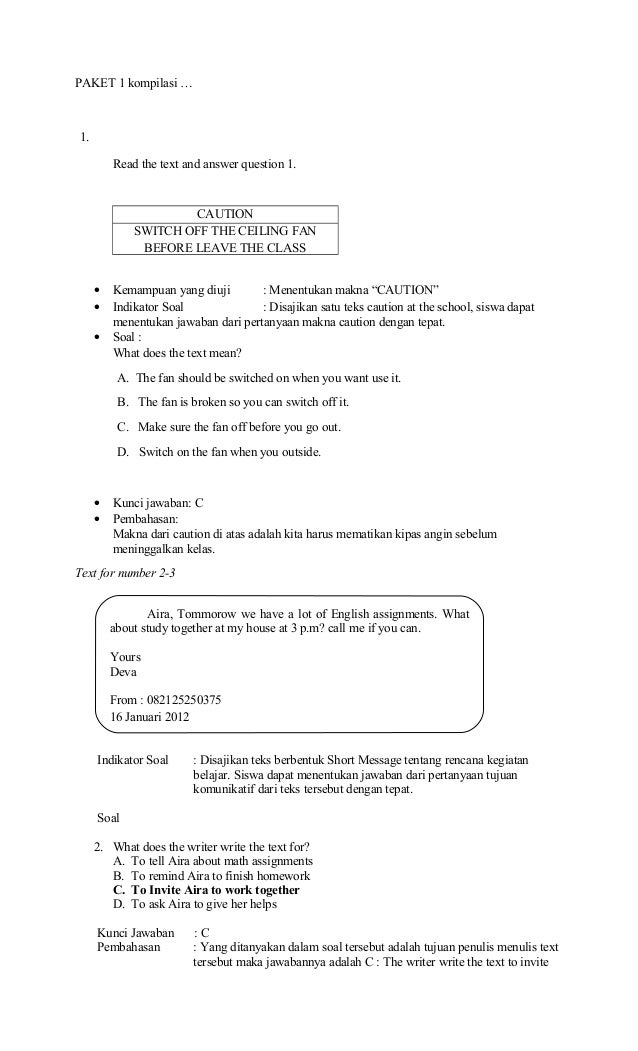

- #SOAL UN BAHASA INGGRIS SMK 2014 DAN PEMBAHASAN HOW TO#
- #SOAL UN BAHASA INGGRIS SMK 2014 DAN PEMBAHASAN UPDATE#
- #SOAL UN BAHASA INGGRIS SMK 2014 DAN PEMBAHASAN DOWNLOAD#
An elephant looks very-clumsy and heavy and yet it can move very quickly. In fact the trunk serves the elephant as a long arm and hand. It can also lift leaves and puts them, into its mouth. The elephant draws up water by its trunk and can squirt it all over its body like a shower bath. The trunk is the elephant’s peculiar feature, and it has various uses. It is a strange looking animal with its thick legs, huge sides and backs, large hanging ears, a small tail, little eyes, long white tusks and above all it has a long nose, the trunk. All of you are good, nice, gentle, and kind …” (Paragraph 2)Īn elephant is the largest and strongest of all animals.We know from the first paragraph that the rabbit actually wanted …Į.the boss of the crocodile and ail his friends Just then, the rabbit started to count while jumping from one crocodile to another: one … two … three … four … until twenty, and finally, he thanked all crocodiles because he had crossed the river.Į.

Then, the boss of the crocodile called all his friends and asked them to make a line in order from one side to the other side of the river. Later I will know how kind you are,” said the rabbit. “All of you are good, nice, gentle and kind, so I want to make a line in order. “What is it for?” the boss of crocodile asked. The rabbit asked the boss of crocodile, “How many crocodiles are there in the river?” The boss of crocodile answered, “We are twenty here.” “Where are they?” the rabbit asked for the second time. He saw a boss of crocodile swimming in the river. Once upon a time, a rabbit wanted to cross a river but he could not swim. Read the following text and answer number 6-8! “The plant obtains carbon and hydrogen dioxide …” (paragraph 2).How many elements which are not very important can be found in the plants?.giving satisfactory growth to the plantsĭ. The topic of paragraph three is about …Ĭ.some of the nutrients are found in the atmosphere chemical analyses indicate that the soil constrains all the nutrients neededĭ.most of the nutrients are bound in compoundsĮ.
#SOAL UN BAHASA INGGRIS SMK 2014 DAN PEMBAHASAN HOW TO#
they do to know how to obtain all the nutrientsī.

Because of this, the farmer is interested in measuring the available nutrient supply as contrasted to the total quantities. Much of this potential supply, however, is bound tightly in forms that are not released to crops fast enough to give satisfactory growth. Overall chemical analyses indicate that the total supply of nutrients in soils is usually high in comparison with the requirements of crop plants. This is also true of silicon and alumunium.īaca juga: Cara cepat kuasai bahasa Inggris tanpa kursus Although the plant contains sodium, iodine, and cobalt, these are apparently not essential. The plan obtains carbon and hydrogen dioxide from the atmosphere other nutrients are taken up from the soil.
%2B(Paket%2B2).png)
In total, the plant has need of at least 16 elements, of which the most important are carbon, hydrogen, oxygen, nitrogen, phosphorus, sulfur, potassium, calcium, and magnesium. Read the following text and answer number 1-5! Contoh Soal UN Bahasa Inggris SMA dan Pembahasan
#SOAL UN BAHASA INGGRIS SMK 2014 DAN PEMBAHASAN UPDATE#
Oleh karena itu, ikuti terus update artikel blog ini. Namun saya akan usahakan untuk membuatnya dalam waktu dekat. Namun harap dimaklumi karena contoh soal yang saya berikan hanya berbentuk ujian tertulis dan tidak termasuk ujian dalam bentuk listening karena terbatasnya waktu dan media yang tersedia. Alasan lain juga untuk mempermudah user yang bermasalah dengan kecepatan loading.
#SOAL UN BAHASA INGGRIS SMK 2014 DAN PEMBAHASAN DOWNLOAD#
Namun yang ditampilkan hanya 15 soal, selengkapnya silahkan download pada link yang terdapat di bawah postingan agar kamu juga bisa print out dan mempelajarinya secara offline. Contoh soal UN bahasa Inggris SMA dan pembahasannya ini berjumlah 50 soal.


 0 kommentar(er)
0 kommentar(er)
